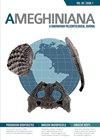Taphonomic Signature of Glycymeris longior Shells (Bivalvia) and its Potential as Paleoenvironmental Proxy for the Quaternary of Northern Patagonia (Argentina)
IF 1.5
4区 地球科学
Q3 PALEONTOLOGY
引用次数: 0
Abstract
Abstract. One of the most abundant species of bivalves found on modern beaches and Quaternary deposits in the San Matías Gulf (Argentinian Patagonia, SW Atlantic Ocean) is Glycymeris longior. Its high abundance and broad geographical distribution turn G. longior into a target species for taphonomical studies. Here, we described the taphonomic signature registered on its shells from San Antonio Bay (San Matías Gulf, Río Negro). This study will contribute to future taphonomic comparisons in the SW Atlantic Ocean, as well as in other Quaternary deposits, and provide insight into the spatial variation of the taphonomic processes influenced by the environment. Glycymeris longior valves from the Holocene Punta Delgado deposits showed two taphonomic signatures whose shell assemblages were differentiated by fragmentation, rounding and cementation intensities. Shells from PD2018A and PD2018B (two sampling localities representing similar environments) were subject to continuous and low-energy water flow. Those remained in a low-intensity hydrodynamic sediment-water interface that would favor high shell cementation. On the other hand, shells from PD2016 were also subject to continuous but more energetic water flow. Those would remain in the taphonomic active zone for enough time to confer smooth edges and to be colonized by clionid sponges but not favorable enough for carbonate precipitation. The Punta Delgado site was interpreted as a protected area during the Holocene (last 4200 yrs.), similar to the modern one, but with differences in carbonate precipitation as the product of differences in water flow intensities. Finally, the high mechanical resistance of G. longior shells, together with its abundance and broad geographical distribution, turn this species into a suitable target taxon for further taphonomic and ecologic analyses and comparisons. Resumen. Una de las especies de bivalvos más abundantes que habita en la playas y depósitos cuaternarios del Golfo San Matías (Patagonia argentina, Océano Atlántico sudoccidental) es Glycymeris longior. Su gran abundancia y amplia distribución geográfica, hacen que G. longior sea una especie objetivo para estudios tafonómicos. Por lo cual, describimos el perfil tafonómico que registran sus valvas en la Bahía San Antonio (Golfo San Matías, Argentina) con el objetivo de contribuir a futuras comparaciones tafonómicas, con material de playas actuales o de depósitos cuaternarios donde esta especie se encuentre. Las valvas de G. longior de los depósitos holocenos de Punta Delgado mostraron dos patrones de preservación diferentes caracterizados por diferencias en la intensidad de fragmentación, redondeamiento y cementación de sus valvas. Las valvas de PD2018A y PD2018B estuvieron sometidas a un flujo de agua continuo y poco intenso. Éstas permanecieron en la interfase sedimento-agua con menor intensidad hidrodinámica, lo que favorecería una alta cementación. Por otro lado, las valvas de PD2016 estuvieron sujetas también a un flujo de agua continuo, pero más intenso o energético. Éstas permanecerían en la zona tafonómicamente activa el tiempo suficiente para producir bordes redondeados y ser colonizadas por las esponjas cliónidas pero no lo suficientemente para la precipitación de carbonatos. El sitio Punta Delgado se interpretó como una zona protegida durante el Holoceno (últimos 4200 años) similar a la actual, pero con diferencias en la precipitación de carbonatos como producto de las distintas intensidades del flujo de agua. Finalmente, la alta resistencia mecánica de las valvas de G. longior, junto con su abundancia y amplia distribución geográfica convierten a esta especie en un taxón adecuado para análisis y comparaciones futuras.阿根廷北部巴塔哥尼亚第四纪古环境标志及双壳类Glycymeris longlongshells的地理特征
摘要在圣Matías湾(阿根廷巴塔哥尼亚,西南大西洋)的现代海滩和第四纪沉积物中发现的最丰富的双壳类之一是Glycymeris longior。其丰富的丰度和广泛的地理分布使其成为地语学研究的目标物种。在这里,我们描述了在圣安东尼奥湾(San Matías Gulf, Río Negro)的壳上注册的地语学特征。该研究将有助于未来西南大西洋以及其他第四纪沉积物的地层学比较,并提供受环境影响的地层学过程的空间变化。全新世Delgado Punta沉积物中的长壳藻具有两种地学特征,其壳组合可通过破碎、圆角和胶结强度来区分。来自PD2018A和PD2018B(两个采样地点代表相似的环境)的贝壳受到连续和低能水流的影响。它们仍然处于低强度的水动力沉积物-水界面,这有利于高壳胶结。另一方面,PD2016的贝壳也受到持续但更有活力的水流的影响。它们会在地学活动区停留足够长的时间,形成光滑的边缘,并被clionid海绵殖民,但对碳酸盐沉淀不够有利。蓬塔德尔加多遗址被解释为全新世(最近4200年)的一个保护区,与现代的相似,但由于水流强度的不同,碳酸盐沉淀有所不同。最后,该物种具有较高的机械抗性,其丰富度和广泛的地理分布使其成为进一步进行地层学和生态学分析和比较的合适目标分类群。Resumen。Una de las species de bivalvos más antes que habita en la playas y depósitos cuaternarios del Golfo San Matías(阿根廷巴塔哥尼亚,ocsamano Atlántico sudociental) es Glycymeris loni。sugran abundance y amplia distribución geográfica, hahaen que G. lonlonsea特别目标为para studios tafonómicos。在阿根廷圣安东尼奥(圣戈福岛Matías),描述了在圣安东尼奥(圣戈福岛Matías)和在未来比较方面的贡献目标(tafonómicas),以及在未来比较方面的实际情况(depósitos)和在未来比较方面的实际情况(特别是在未来比较方面)。拉斯维加斯瓣膜de g . longior de los depositos holocenos de制盐业Delgado mostraron dos赞助人de preservacion不同caracterizados为什么diferencias en la intensidad de fragmentacion redondeamiento y cementacion de sus瓣膜。Las valvas de PD2018A和PD2018B的研究有时会产生一种不稳定的液体,这种液体可以持续到poco强度。Éstas永久沉淀-水界面沉积-水界面富集hidrodinámica, lo que favorecería una alta cementación。总理又,拉斯维加斯瓣膜de PD2016 estuvieron sujetas加入联合国变窄阿瓜数字低音,佩罗mas intenso o energetico。Éstas permanecerían en la zona tafonómicamente activa el time - to - enough para productides ides - as - colonizadas - as - esponjas cliónidas pero - to - fulentemente para la precipitación de carbonatos。El sitio Punta Delgado se interpretó como una zone protegida durante El Holoceno (últimos 4200 años)类似于la la la precipitación de carbonatos como producto de las distintides del flujo de agua。最后,la alta resistance mecánica de las valvas de G. lonor, junto con abundance by amplia distribución geográfica converconvera esta,特别是在taxón adecuado para análisis y comparaciones futuras。
本文章由计算机程序翻译,如有差异,请以英文原文为准。
求助全文
约1分钟内获得全文
求助全文
来源期刊

Ameghiniana
地学-古生物学
CiteScore
2.50
自引率
10.00%
发文量
21
期刊介绍:
Ameghiniana is a bimonthly journal that publishes original contributions on all disciplines related to paleontology, with a special focus on the paleontology of Gondwana and the biotic history of the southern hemisphere. Published yearly since 1957, it has undoubtedly become the main palaeontological publication from Latin America. Ameghiniana has recently broadened its editorial board, reorganized its production process, and increased to a bimonthly frequency, which resulted in a significant decrease in the turn around time.
 求助内容:
求助内容: 应助结果提醒方式:
应助结果提醒方式:


